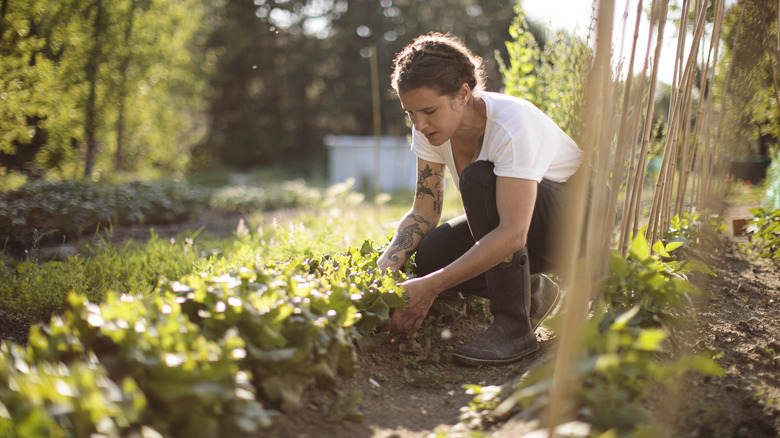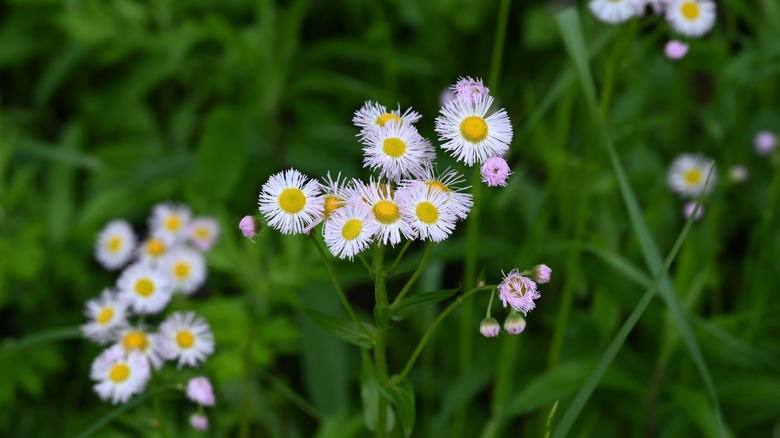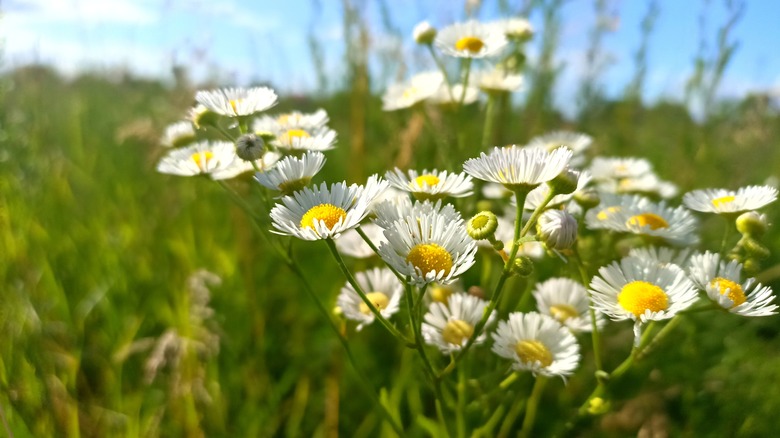The Colorful & Fast-Growing Flower That Makes A Beautiful Ground Cover
Looking for a flower that doubles as a beautiful ground cover plant? An unassuming wildflower called fleabane (Erigeron spp.) could do just the trick. Though it's not the most flashy pick (and definitely doesn't have the cutest name), this herbaceous perennial from the daisy family features dainty white, pink, or blueish blooms that will spread quickly and jazz up any garden. It comes in many variations, is super easy to grow, and fares best in USDA Hardiness Zones 2 through 9.
Fleabane is native to most of the United States and has a storied history as a medicinal herb with a variety of uses. Fun fact: Its name actually comes from an old superstition that its flowers could be dried in clusters and used to deter fleas. Today, however, it's often found growing on roadsides or planted in gardens to draw in pollinators, such as butterflies, bees, and moths. Plant this wildflower on your property, and you'll be doing your part to attract insects that play a key role in your local ecosystem. You'll want to keep an eye on its growth, though. Certain varieties of fleabane can become weedy and spread to parts of your garden where they're not wanted.
How to plant and care for fleabane
Depending on the variety, fleabane flowers sometime between spring and fall — if you're planting it from seed, aim for late spring or early fall. Choose a spot that receives full sun or partial shade, but nothing more. This plant needs a lot of light to thrive. You'll also want to ensure that the soil drains decently well. If you're replanting multiple fleabane plants from a nursery, spread them out so they have room to grow.
Once established, this plant is fairly low-maintenance and doesn't need to be babysat. (Watch it closely, and you'll notice that its opened blooms close once the sun has gone down at night. Cool, right?) Fleabane is a naturally drought-tolerant ground cover, so water it sparsely, and keep an eye on its spread to make sure that it stays contained. Also, watch out for aphids and spider mites, which are known to afflict this plant in some areas. If you feel so inclined, you can deadhead fleabane's spent blooms. This will prolong its flowering period, allowing you to enjoy those dainty blooms well into summer and maybe even into fall.
Explore the different varieties of fleabane
Interested in planting fleabane in your garden? You'll need to research which of its 170 variations nationwide is right for you. Again, this plant is native to North America, so invasive status isn't a concern. However, some varieties favor specific conditions or exhibit different growing tendencies. Philadelphia fleabane (E. philadelphicus) is one common subtype. As the name suggests, this colorful wildflower you can grow in your garden is typically found in the eastern part of the United States. It's considered a biennial, or short-lived perennial, and does best in full sun. There's annual fleabane (E. annuus), which isn't as hardy as other variations and thus classified as an annual. See also: durable featherleaf fleabane (E. pinnatisectus), which grows well in cold, dry, and elevated conditions and is widespread throughout the Rocky Mountains in Colorado.
Additionally, you may want to consider planting a hybrid version of this plant. These generally look more refined and spread less aggressively than their wildflower counterparts. For instance, the popular daisy fleabane (E. speciosus) comes in many hybrid variations. It can be an annual or biennial plant, depending on the weather conditions in your area. Like Philadelphia fleabane, it thrives in full sun and well-drained soil.


